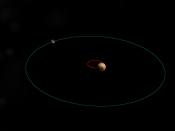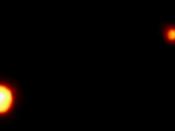Pluto....A Controversial Planet!
Pluto is a very controversial planet. The reason for this is because it's a dark and distant planet and it's hard to study it clearly enough to be satisfied. Pluto was discovered in 1930 by an astronomer by the name of Clyde Tombaugh. Then James Christy and Robert Harrington discovered Pluto had a satellite, they named it Charon. Pluto and Charon are referred to as double planets. Some of the facts, or measurements, that we know about Pluto are from discovery efforts such as new inventions and long studies. There was supposed to be a scheduled mission in 2001 called the "Pluto Express Mission," and was expected to arrive at Pluto around 2006-2008, but there's no source that could tell if that went ahead as planned or if it was cancelled.
From these discovery efforts we learned some data on Pluto. Specifically the measurements compared to the earth.
So, the distance of Pluto from the sun is 5,913,520 x 103 kilometers, and Earth's is 149,600 x 10 3 kilometers. This should give an idea of how far away Pluto is in comparison. Another comparison between Pluto and Earth would be the radius of Pluto compared to the radius of the Earth. Pluto's radius is 1160 and Pluto's moon, Charon, diameter is 1,172 kilometers (728 miles), just over half the size of Pluto. The Earth's radius is roughly 6378 kilometers, nearly 6 times the size of Pluto! Next, will be the density of each Pluto and the Earth in comparison. Pluto's density is 2.05 g/cm3 and the Earth's density is 5.52 g/cm3. This means Pluto may be smaller but it still has a lot of density to it. The Orbital Period of Pluto is a lot longer than the Earth's because of obvious reasons. Those would...



Cool
Your essay was insightful. My thought is, Is it possible that one day Pluto might not be in our solar system any more? If that is posssible wouldnt it be possible that Earth at one time was part of another system? And will the earth be forced to move farther away from the sun as Pluto once did? WHat do you think? Isnt it scary to think what the possibilties may be? Good job on your essay.
3 out of 3 people found this comment useful.